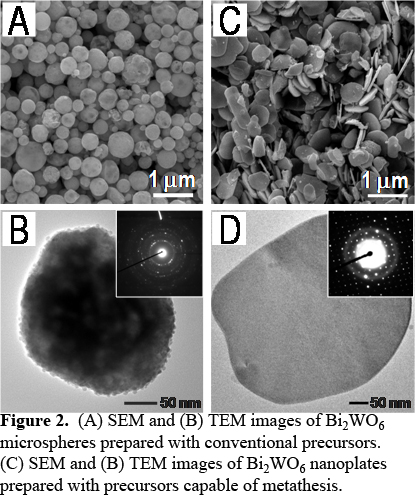AmericanChemicalSociety.com
Reports: DNI10 48790-DNI10: Electrospray Synthesis of Composite Photocatalysts with Controlled Architectures
Sara E. Skrabalak, PhD, Indiana University (Bloomington)
Of primary importance is the development of efficient means to harness the huge energy potential of solar irradiation and use it to drive chemical reactions or convert it into stored chemical energy. To meet this goal, our support from ACS-PRF has been directed towards the aerosol synthesis of photocatalysts that are i) compositionally- and/or ii) architecturally-diverse. Two avenues in research in particular have flourished, as summarized below.
Both
targets have been successfully synthesized by adding preformed nanoparticles of
the undoped M2xOy component to a sol-gel precursor
solution for the nitrogen-doped M1xOy component. After gelation and solvent removal, the
composite is annealed to crystallize the nitrogen-doped M1xOy
phase. Electron microscopy and X-ray
powder diffraction (XRD) confirmed the formation of the composites, while EPR
confirmed dopant incorporation (Figures 1B-E).
Analysis by X-ray photoelectron spectroscopy (XPS) is underway. The photodegradation of rhodamine B has been
selected as a model system to evaluate their photocatalytic potential. Preliminary results indicate a strong
dependence on the ratio of the two composite components under UV-visible
irradiation, with the nitrogen-doped component serving as a sensitizer at low
concentrations. At higher concentrations,
performance decreases presumably due to the greater number of recombination
sites associated with the nitrogen-doped phase.
A full paper will be submitted after catalyst testing is completed. Part B. Owing to the synthetic challenges encountered
when electrospray was employed, we switched to ultrasonic spray pyrolysis as a
means of aerosol generation for the synthesis of compositionally and
architecturally-diverse photocatalysts.
Bi2WO6 was selected as the initial synthetic
target given its promise as a visible light photocatalyst to be incorporated
into Z-scheme composites for overall water splitting. To
produce compositionally complex materials such as Bi2WO6,
precursors are typically selected so that upon pyrolysis, only the desired
material and small gaseous byproducts are generated. This selection leads to the formation of
polycrystalline microspheres. However,
precursors capable of metathesis were selected (BiOCl + Na2WO6 à Bi2WO6 +
NaCl) in order to generate a non-transient byproduct salt for
templating. Surprisingly, Bi2WO6
nanoplates were produced rather than porous particles, which contrast greatly
with the microspheres obtained Broader Impact. The current ACS-PRF grant has been
effectively used to attract and support the work of one postdoctoral associate
and two graduate students. The PI and
postdoctoral associate presented results from these projects at the spring and
fall 2009 MRS conferences, respectively.
The postdoctoral associate has now started her independent career as a
faculty member at a PUI. One graduate
student recently completed his master's degree in chemistry. The second graduate student presented results
at the 2010 CERMACS conference. These
preliminary results formed the basis of the recently funded NSF CAREER Award
proposal (DMR-0955028), which will financially support this work further.
 Part A. As outlined in
the proposal, we sought to validate nitrogen-doped M1xOy/M2xOy
composites prepared by an electrospray method as a new class of Z-scheme photocatalysts
in which the nitrogen-doped unit would enhance visible light absorption while
composite formation would enhance electron-hole separation (see Figure 1A). Initial synthetic targets included
nitrogen-doped In2O3/TiO2 and nitrogen-doped
TiO2/SnO2. Urea,
NH4OH, and NH4Cl were found to be suitable nitrogen
sources; however, the high concentrations required for the syntheses inhibited
the formation of high-quality samples by electrospray. Thus, a solution based route towards these
composites has been developed instead.
Part A. As outlined in
the proposal, we sought to validate nitrogen-doped M1xOy/M2xOy
composites prepared by an electrospray method as a new class of Z-scheme photocatalysts
in which the nitrogen-doped unit would enhance visible light absorption while
composite formation would enhance electron-hole separation (see Figure 1A). Initial synthetic targets included
nitrogen-doped In2O3/TiO2 and nitrogen-doped
TiO2/SnO2. Urea,
NH4OH, and NH4Cl were found to be suitable nitrogen
sources; however, the high concentrations required for the syntheses inhibited
the formation of high-quality samples by electrospray. Thus, a solution based route towards these
composites has been developed instead.  when
conventional precursors are employed (Figure 2). Differential
scanning calorimetry and thermal gravimetric analysis of the various precursor
combinations indicate that the different decomposition pathways and generated
byproducts account for the varying particle structures. The synthesis of shape-controlled particles
provides a platform for elucidating structure-function properties. Thus, both the Bi2WO6
nanoplates and microspheres were evaluated as photocatalysts for the
degradation of rhodamine B and compared to Bi2WO6
prepared by solid-state heating of the parent oxides. While the nanoplates had the highest surface
area, the microspheres facilitated the greatest rate of dye degradation. XPS analysis and dye adsorption studies
indicate that the expression of hydrophilic surfaces, as is the case with the
Bi2WO6 microspheres, enhances photocatalytic performance. A manuscript has been submitted and the
versatility of this approach to other shape-controlled nanostructures is being
probed.
when
conventional precursors are employed (Figure 2). Differential
scanning calorimetry and thermal gravimetric analysis of the various precursor
combinations indicate that the different decomposition pathways and generated
byproducts account for the varying particle structures. The synthesis of shape-controlled particles
provides a platform for elucidating structure-function properties. Thus, both the Bi2WO6
nanoplates and microspheres were evaluated as photocatalysts for the
degradation of rhodamine B and compared to Bi2WO6
prepared by solid-state heating of the parent oxides. While the nanoplates had the highest surface
area, the microspheres facilitated the greatest rate of dye degradation. XPS analysis and dye adsorption studies
indicate that the expression of hydrophilic surfaces, as is the case with the
Bi2WO6 microspheres, enhances photocatalytic performance. A manuscript has been submitted and the
versatility of this approach to other shape-controlled nanostructures is being
probed.
Copyright © American Chemical Society

